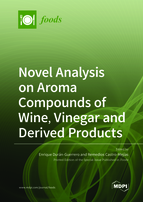Novel Analysis on Aroma Compounds of Wine, Vinegar and Derived Products
A special issue of Foods (ISSN 2304-8158). This special issue belongs to the section "Food Physics and (Bio)Chemistry".
Deadline for manuscript submissions: closed (20 February 2021) | Viewed by 45789
Special Issue Editors
Interests: wine; vinegar; oenological products; polyphenols; volatile compounds; chromatography; food analysis; food quality; sensory analysis; extraction
Special Issues, Collections and Topics in MDPI journals
Interests: enological products; chromatography techniques; polyphenols; volatile compounds; chromatography; food analysis; food quality; sensory analysis; extraction; food composition; food science and technology
Special Issues, Collections and Topics in MDPI journals
Special Issue Information
Dear Colleagues,
Aroma compounds are one of the main responsible for the acceptance of oenological products such as wine, vinegar and derived products. This kind of compounds are produced during the winemaking process and they can be affected by natural, geographical and human factors: raw material, alcoholic and acetic fermentation, ageing, distillation, technological processes, etc. Therefore, it is very important to study and to characterize the aromatic fraction of these oenological beverages, in order to improve the quality of the final product.
This special issue will be focused on the recent researches related to the study of the volatile composition of wine, vinegar and derived products, from many different fields of science: Oenology, Chemistry, Food Science and Technology, Biochemistry, Microbiology, Biotechnology, Engineering, Sensory Analysis, etc.
Prof. Enrique Durán-Guerrero
Prof. Remedios Castro-Mejías
Guest Editors
Manuscript Submission Information
Manuscripts should be submitted online at www.mdpi.com by registering and logging in to this website. Once you are registered, click here to go to the submission form. Manuscripts can be submitted until the deadline. All submissions that pass pre-check are peer-reviewed. Accepted papers will be published continuously in the journal (as soon as accepted) and will be listed together on the special issue website. Research articles, review articles as well as short communications are invited. For planned papers, a title and short abstract (about 100 words) can be sent to the Editorial Office for announcement on this website.
Submitted manuscripts should not have been published previously, nor be under consideration for publication elsewhere (except conference proceedings papers). All manuscripts are thoroughly refereed through a single-blind peer-review process. A guide for authors and other relevant information for submission of manuscripts is available on the Instructions for Authors page. Foods is an international peer-reviewed open access semimonthly journal published by MDPI.
Please visit the Instructions for Authors page before submitting a manuscript. The Article Processing Charge (APC) for publication in this open access journal is 2900 CHF (Swiss Francs). Submitted papers should be well formatted and use good English. Authors may use MDPI's English editing service prior to publication or during author revisions.
Keywords
- Wine
- Vinegar
- Distillates
- New Products
- Chromatography
- Volatile Compounds
- Characterization
- Extraction








